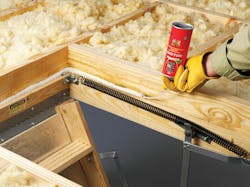Seal in Savings and Satisfy Customers with Air Sealing Solutions
During the home renovation process, homeowners commonly focus time and energy on visible design elements ranging from crown molding for the living room, to countertops for the kitchen, to tiling for the bathroom. It is equally important, however, to focus attention on some of the less-visible aspects of the house such as insulation and air sealing, which contribute to the overall health, comfort and efficiency of the home. So while you’re working with customers to plan home renovation projects, why not encourage homeowners to do both?
With energy prices increasing across every sector with no immediate relief in sight, consumers are expected to pay more to keep their homes comfortable. In 2010, households paid $1,419 – the fifth consecutive yearly increase above the inflation rate, according to a 2011 USA TODAY analysis. The rise has increased electricity costs by approximately $300 per year – the largest sustained increase since the 1970s. As homeowners look to do fall home improvement projects ahead of winter, now is the perfect time to encourage your customers to create a tightly air-sealed and insulated home. Along with other planned projects, this is an easy and inexpensive project for you that will help them save money instantly, taking the pinch out of the otherwise escalating monthly utility bills as well as allowing them to improve the comfort and indoor air quality of their home.
Easy and Cost Efficient Projects
Insulation and air sealing solutions are frequently overlooked by both homeowners and remodeling contractors. However, they are the most effective methods to help prevent uncomfortable and potentially costly situations in the home, such as drafty rooms, hot or cold spots in living spaces, roof ice dams, and mold and mildew. With more than a half mile of gaps and cracks throughout the average mid-sized U.S. home, there is a significant opportunity to improve the air sealing systems and insulation in existing homes. These techniques also help to reduce air infiltration including dust and allergens as well as the entry of insects and other pests.
Seal Unwanted Air Leaks Throughout the Home
Sealing unwanted air leaks is one of the easiest, cheapest and most frequently overlooked ways to increase a home’s energy efficiency and help protect against moisture intrusion. The U.S. Environmental Protection Agency (EPA) estimates homeowners can save up to 30 percent on heating and cooling costs by air sealing and insulating their home.2 Insulating foam sealants like GREAT STUFF PRO™ products are inexpensive and simple to apply in a home. For example, Dow Building Solutions and Cobblestone Homes, a Great Lakes Bay Region home builder, joined together to create a living “case study” to broaden public awareness of the opportunity for energy-efficient retrofits. Revitalize Home showcases practical, energy-efficient remodeling projects that help builders and remodelers “revitalize” the renovation process with insulating foam sealants. These home improvements are a logical sell-in project for your customers and allow you to take on an easy and low-resource project; otherwise known as a win-win!
Helping Homeowners Protect A Long-Term Investment
A well-insulated and sealed home is better able to maintain structural integrity and long-term indoor air quality for homeowners. The results are favorable living conditions in a home that provides cost-saving energy efficiency, draft-free comfort, greater indoor air quality and enhanced temperature control.
Take the Chill Out of Unrealized Energy Loss
You wouldn’t go outside on a cold day without zipping up your jacket, so why would you only insulate between the studs and leave 25 percent of the wall un-insulated? In a typical American home, wood framing accounts for 25 percent of a wall’s surface and when left un-insulated, framing contributes to significant energy loss known as thermal bridging. Ensuring that the home has continuous exterior insulation will provide a solid layer of insulation that covers the entire wall, including the wood studs, reducing energy loss through the walls. By taking this measure, homeowners will also benefit from enjoying more consistent temperatures, greater comfort and energy savings. Communicating this benefit to your customers means they will see improvements from a cost savings perspective as well as live in a more comfortable, temperature-controlled home.
Unlike new appliances and tile, investing in insulation and air sealing is an easy value-add solution that will begin to pay your customers back from day one with a more durable, comfortable and efficient home with reduced energy costs. Doing easy and cost-efficient projects that create a more comfortable home for your customers will also help increase your customer satisfaction rating, helping to drive more referrals.
